Geometry
| Geometry |
|---|
plane |
| Geometers |
| Part of a series on | ||
| Mathematics | ||
|---|---|---|
|
|
||
|
| ||
Geometry (from
Originally developed to model the physical world, geometry has applications in almost all sciences, and also in art, architecture, and other activities that are related to graphics.[4] Geometry also has applications in areas of mathematics that are apparently unrelated. For example, methods of algebraic geometry are fundamental in Wiles's proof of Fermat's Last Theorem, a problem that was stated in terms of elementary arithmetic, and remained unsolved for several centuries.
During the 19th century several discoveries enlarged dramatically the scope of geometry. One of the oldest such discoveries is
Since the late 19th century, the scope of geometry has been greatly expanded, and the field has been split in many subfields that depend on the underlying methods—
History
The earliest recorded beginnings of geometry can be traced to ancient
In the 7th century BC, the
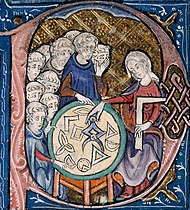
In the
In the early 17th century, there were two important developments in geometry. The first was the creation of analytic geometry, or geometry with coordinates and equations, by René Descartes (1596–1650) and Pierre de Fermat (1601–1665).[30] This was a necessary precursor to the development of calculus and a precise quantitative science of physics.[31] The second geometric development of this period was the systematic study of projective geometry by Girard Desargues (1591–1661).[32] Projective geometry studies properties of shapes which are unchanged under projections and sections, especially as they relate to artistic perspective.[33]
Two developments in geometry in the 19th century changed the way it had been studied previously.
Main concepts
The following are some of the most important concepts in geometry.[3][36]
Axioms
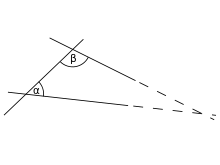
Objects
Points
Points are generally considered fundamental objects for building geometry. They may be defined by the properties that they must have, as in Euclid's definition as "that which has no part",
With these modern definitions, every geometric shape is defined as a set of points; this is not the case in synthetic geometry, where a line is another fundamental object that is not viewed as the set of the points through which it passes.
However, there are modern geometries in which points are not primitive objects, or even without points.[44][45] One of the oldest such geometries is Whitehead's point-free geometry, formulated by Alfred North Whitehead in 1919–1920.
Lines
Euclid described a line as "breadthless length" which "lies equally with respect to the points on itself".[43] In modern mathematics, given the multitude of geometries, the concept of a line is closely tied to the way the geometry is described. For instance, in analytic geometry, a line in the plane is often defined as the set of points whose coordinates satisfy a given linear equation,[46] but in a more abstract setting, such as incidence geometry, a line may be an independent object, distinct from the set of points which lie on it.[47] In differential geometry, a geodesic is a generalization of the notion of a line to curved spaces.[48]
Planes
In Euclidean geometry a plane is a flat, two-dimensional surface that extends infinitely;[43] the definitions for other types of geometries are generalizations of that. Planes are used in many areas of geometry. For instance, planes can be studied as a topological surface without reference to distances or angles;[49] it can be studied as an affine space, where collinearity and ratios can be studied but not distances;[50] it can be studied as the complex plane using techniques of complex analysis;[51] and so on.
Angles
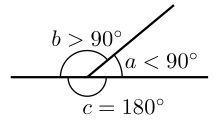
In Euclidean geometry, angles are used to study polygons and triangles, as well as forming an object of study in their own right.[43] The study of the angles of a triangle or of angles in a unit circle forms the basis of trigonometry.[53]
In
Curves
A
In topology, a curve is defined by a function from an interval of the real numbers to another space.
Surfaces

A
Solids

A
Manifolds
A
Manifolds are used extensively in physics, including in general relativity and string theory.[60]
Measures: length, area, and volume
Length, area, and volume describe the size or extent of an object in one dimension, two dimension, and three dimensions respectively.[61]
In Euclidean geometry and analytic geometry, the length of a line segment can often be calculated by the Pythagorean theorem.[62]
Area and volume can be defined as fundamental quantities separate from length, or they can be described and calculated in terms of lengths in a plane or 3-dimensional space.
Other geometrical measures include the
Metrics and measures
The concept of length or distance can be generalized, leading to the idea of
In a different direction, the concepts of length, area and volume are extended by
Congruence and similarity
Congruence and similarity are generalized in transformation geometry, which studies the properties of geometric objects that are preserved by different kinds of transformations.[70]
Compass and straightedge constructions
Classical geometers paid special attention to constructing geometric objects that had been described in some other way. Classically, the only instruments used in most geometric constructions are the
Rotation and orientation
The geometrical concepts of rotation and orientation define part of the placement of objects embedded in the plane or in space.
Dimension
Where the traditional geometry allowed dimensions 1 (a
In
Symmetry
The theme of symmetry in geometry is nearly as old as the science of geometry itself.[75] Symmetric shapes such as the circle, regular polygons and platonic solids held deep significance for many ancient philosophers[76] and were investigated in detail before the time of Euclid.[39] Symmetric patterns occur in nature and were artistically rendered in a multitude of forms, including the graphics of Leonardo da Vinci, M. C. Escher, and others.[77] In the second half of the 19th century, the relationship between symmetry and geometry came under intense scrutiny. Felix Klein's Erlangen program proclaimed that, in a very precise sense, symmetry, expressed via the notion of a transformation group, determines what geometry is.[78] Symmetry in classical Euclidean geometry is represented by congruences and rigid motions, whereas in projective geometry an analogous role is played by collineations, geometric transformations that take straight lines into straight lines.[79] However it was in the new geometries of Bolyai and Lobachevsky, Riemann, Clifford and Klein, and Sophus Lie that Klein's idea to 'define a geometry via its symmetry group' found its inspiration.[80] Both discrete and continuous symmetries play prominent roles in geometry, the former in topology and geometric group theory,[81][82] the latter in Lie theory and Riemannian geometry.[83][84]
A different type of symmetry is the principle of duality in projective geometry, among other fields. This meta-phenomenon can roughly be described as follows: in any theorem, exchange point with plane, join with meet, lies in with contains, and the result is an equally true theorem.[85] A similar and closely related form of duality exists between a vector space and its dual space.[86]
Contemporary geometry
Euclidean geometry
Euclidean vectors
Euclidean vectors are used for a myriad of applications in physics and engineering, such as position, displacement, deformation, velocity, acceleration, force, etc.
Differential geometry
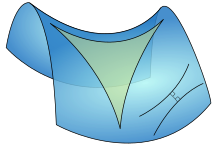
Differential geometry uses techniques of calculus and linear algebra to study problems in geometry.[95] It has applications in physics,[96] econometrics,[97] and bioinformatics,[98] among others.
In particular, differential geometry is of importance to
Non-Euclidean geometry

Topology

Topology is the field concerned with the properties of
The field of topology, which saw massive development in the 20th century, is in a technical sense a type of transformation geometry, in which transformations are homeomorphisms.[103] This has often been expressed in the form of the saying 'topology is rubber-sheet geometry'. Subfields of topology include geometric topology, differential topology, algebraic topology and general topology.[104]
Algebraic geometry

Algebraic geometry is fundamentally the study by means of
Algebraic geometry has applications in many areas, including cryptography[108] and string theory.[109]
Complex geometry
Complex geometry first appeared as a distinct area of study in the work of Bernhard Riemann in his study of Riemann surfaces.[114][115][116] Work in the spirit of Riemann was carried out by the Italian school of algebraic geometry in the early 1900s. Contemporary treatment of complex geometry began with the work of Jean-Pierre Serre, who introduced the concept of sheaves to the subject, and illuminated the relations between complex geometry and algebraic geometry.[117][118] The primary objects of study in complex geometry are
Discrete geometry
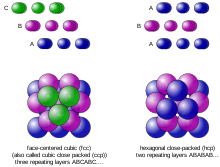
Discrete geometry is a subject that has close connections with convex geometry.[119][120][121] It is concerned mainly with questions of relative position of simple geometric objects, such as points, lines and circles. Examples include the study of sphere packings, triangulations, the Kneser-Poulsen conjecture, etc.[122][123] It shares many methods and principles with combinatorics.
Computational geometry
Although being a young area of geometry, it has many applications in
Geometric group theory

Geometric group theory uses large-scale geometric techniques to study finitely generated groups.[126] It is closely connected to low-dimensional topology, such as in Grigori Perelman's proof of the Geometrization conjecture, which included the proof of the Poincaré conjecture, a Millennium Prize Problem.[127]
Geometric group theory often revolves around the
Convex geometry
Convex geometry dates back to antiquity.
Applications
Geometry has found applications in many fields, some of which are described below.
Art
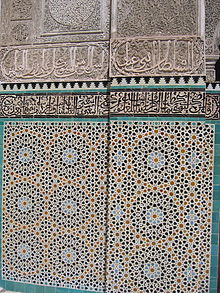
Mathematics and art are related in a variety of ways. For instance, the theory of perspective showed that there is more to geometry than just the metric properties of figures: perspective is the origin of projective geometry.[130]
Artists have long used concepts of proportion in design. Vitruvius developed a complicated theory of ideal proportions for the human figure.[131] These concepts have been used and adapted by artists from Michelangelo to modern comic book artists.[132]
The golden ratio is a particular proportion that has had a controversial role in art. Often claimed to be the most aesthetically pleasing ratio of lengths, it is frequently stated to be incorporated into famous works of art, though the most reliable and unambiguous examples were made deliberately by artists aware of this legend.[133]
Architecture
Geometry has many applications in architecture. In fact, it has been said that geometry lies at the core of architectural design.
Physics
The field of astronomy, especially as it relates to mapping the positions of stars and planets on the celestial sphere and describing the relationship between movements of celestial bodies, have served as an important source of geometric problems throughout history.[140]
Other fields of mathematics
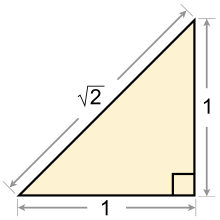
Another important area of application is
See also
- Lists
- List of geometers
- List of formulas in elementary geometry
- List of geometry topics
- List of important publications in geometry
- Lists of mathematics topics
- Related topics
- Descriptive geometry
- Flatland, a book written by Edwin Abbott Abbott about two- and three-dimensional space, to understand the concept of four dimensions
- List of interactive geometry software
- Other applications
Notes
- Desargues in the 17th century, all the way back to the implicit use of spherical geometry to understand the Earth geodesyand to navigate the oceans since antiquity.
- ^ Pythagorean triples are triples of integers with the property: . Thus, , , etc.
- ^ The ancient Greeks had some constructions using other instruments.
References
- ^ "Geometry - Formulas, Examples | Plane and Solid Geometry". Cuemath. Retrieved 31 August 2023.
- ISBN 978-3-319-12102-4. Archivedfrom the original on 20 February 2021. Retrieved 14 September 2019.
- ^ ISBN 978-0-8160-4953-0.
- ISBN 978-0-08-047803-6. Archivedfrom the original on 1 September 2021. Retrieved 14 September 2019.
- .
- ISBN 978-0-486-22332-2. Archivedfrom the original on 14 August 2020. Retrieved 27 February 2021..
- ^ (Boyer 1991, "Egypt" p. 19)
- S2CID 206644971.
- JSTOR 3822211.
- ^ Slayman, Andrew (27 May 1998). "Neolithic Skywatchers". Archaeology Magazine Archive. Archived from the original on 5 June 2011. Retrieved 17 April 2011.
- ^ (Boyer 1991, "Ionia and the Pythagoreans" p. 43)
- ISBN 0-03-029558-0.
- JSTOR 1969021.
- from the original on 9 September 2022. Retrieved 9 September 2022.
- ^ (Boyer 1991, "The Age of Plato and Aristotle" p. 92)
- ^ (Boyer 1991, "Euclid of Alexandria" p. 119)
- ^ (Boyer 1991, "Euclid of Alexandria" p. 104)
- The Bible, has been more widely used...."
- ^ O'Connor, J.J.; Robertson, E.F. (February 1996). "A history of calculus". University of St Andrews. Archived from the original on 15 July 2007. Retrieved 7 August 2007.
- S2CID 170894641.
- ^ (Cooke 2005, p. 198): "The arithmetic content of the Śulva Sūtras consists of rules for finding Pythagorean triples such as (3, 4, 5), (5, 12, 13), (8, 15, 17), and (12, 35, 37). It is not certain what practical use these arithmetic rules had. The best conjecture is that they were part of religious ritual. A Hindu home was required to have three fires burning at three different altars. The three altars were to be of different shapes, but all three were to have the same area. These conditions led to certain "Diophantine" problems, a particular case of which is the generation of Pythagorean triples, so as to make one square integer equal to the sum of two others."
- ^ (Hayashi 2005, p. 371)
- ^ a b (Hayashi 2003, pp. 121–122)
- OCLC 29181926.
- ^ (Boyer 1991, "The Arabic Hegemony" pp. 241–242) "Omar Khayyam (c. 1050–1123), the "tent-maker," wrote an Algebra that went beyond that of al-Khwarizmi to include equations of third degree. Like his Arab predecessors, Omar Khayyam provided for quadratic equations both arithmetic and geometric solutions; for general cubic equations, he believed (mistakenly, as the 16th century later showed), arithmetic solutions were impossible; hence he gave only geometric solutions. The scheme of using intersecting conics to solve cubics had been used earlier by Menaechmus, Archimedes, and Alhazan, but Omar Khayyam took the praiseworthy step of generalizing the method to cover all third-degree equations (having positive roots). .. For equations of higher degree than three, Omar Khayyam evidently did not envision similar geometric methods, for space does not contain more than three dimensions, ... One of the most fruitful contributions of Arabic eclecticism was the tendency to close the gap between numerical and geometric algebra. The decisive step in this direction came much later with Descartes, but Omar Khayyam was moving in this direction when he wrote, "Whoever thinks algebra is a trick in obtaining unknowns has thought it in vain. No attention should be paid to the fact that algebra and geometry are different in appearance. Algebras are geometric facts which are proved."".
- ^ O'Connor, John J.; Robertson, Edmund F. "Al-Mahani". MacTutor History of Mathematics Archive. University of St Andrews.
- ^ O'Connor, John J.; Robertson, Edmund F. "Al-Sabi Thabit ibn Qurra al-Harrani". MacTutor History of Mathematics Archive. University of St Andrews.
- ^ O'Connor, John J.; Robertson, Edmund F. "Omar Khayyam". MacTutor History of Mathematics Archive. University of St Andrews.
- ^ Boris A. Rosenfeld and Adolf P. Youschkevitch (1996), "Geometry", in Roshdi Rashed, ed., Encyclopedia of the History of Arabic Science, Vol. 2, pp. 447–494 [470], Routledge, London and New York:
"Three scientists, Ibn al-Haytham, Khayyam, and al-Tusi, had made the most considerable contribution to this branch of geometry whose importance came to be completely recognized only in the 19th century. In essence, their propositions concerning the properties of quadrangles which they considered, assuming that some of the angles of these figures were acute of obtuse, embodied the first few theorems of the hyperbolic and the elliptic geometries. Their other proposals showed that various geometric statements were equivalent to the Euclidean postulate V. It is extremely important that these scholars established the mutual connection between this postulate and the sum of the angles of a triangle and a quadrangle. By their works on the theory of parallel lines Arab mathematicians directly influenced the relevant investigations of their European counterparts. The first European attempt to prove the postulate on parallel lines—made by Witelo, the Polish scientists of the 13th century, while revising Ibn al-Haytham's Book of Optics (Kitab al-Manazir)—was undoubtedly prompted by Arabic sources. The proofs put forward in the 14th century by the Jewish scholar Levi ben Gerson, who lived in southern France, and by the above-mentioned Alfonso from Spain directly border on Ibn al-Haytham's demonstration. Above, we have demonstrated that Pseudo-Tusi's Exposition of Euclid had stimulated both J. Wallis's and G. Saccheri's studies of the theory of parallel lines."
- ^ ISBN 978-0-486-15451-0. Archivedfrom the original on 26 December 2019. Retrieved 18 September 2019.
- ISBN 978-1-4612-6230-5. Archivedfrom the original on 29 December 2019. Retrieved 18 September 2019.
- ISBN 978-1-4613-8692-6. Archivedfrom the original on 27 December 2019. Retrieved 18 September 2019.
- ISBN 978-0-486-14170-1. Archivedfrom the original on 28 December 2019. Retrieved 18 September 2019.
- ISBN 978-0-85729-060-1. Archivedfrom the original on 7 December 2019. Retrieved 18 September 2019.
- ISBN 978-3-319-74830-6. Archivedfrom the original on 28 December 2019. Retrieved 18 September 2019.
- ISBN 978-0-19-506137-6. Archivedfrom the original on 1 September 2021. Retrieved 14 September 2019.
- ISBN 978-0-88385-163-0. Archivedfrom the original on 1 September 2021. Retrieved 14 September 2019.
- ISBN 978-0-465-03863-3.
- ^ ISBN 978-0-387-22676-7. Archivedfrom the original on 1 September 2021. Retrieved 14 September 2019.
- ISBN 978-1-351-97353-3. Archivedfrom the original on 1 September 2021. Retrieved 14 September 2019.
- ISBN 978-1-4612-6135-3. Archivedfrom the original on 1 September 2021. Retrieved 14 September 2019.
- ISBN 978-3-642-14441-7. Archivedfrom the original on 1 September 2021. Retrieved 14 September 2019.
- ^ ISBN 1-888009-18-7.
- ^ Gerla, G. (1995). "Pointless Geometries" (PDF). In Buekenhout, F.; Kantor, W. (eds.). Handbook of incidence geometry: buildings and foundations. North-Holland. pp. 1015–1031. Archived from the original (PDF) on 17 July 2011.
- .
- ^ John Casey (1885). Analytic Geometry of the Point, Line, Circle, and Conic Sections.
- from the original on 1 March 2023. Retrieved 9 September 2022.
- OxfordDictionaries.com. Archived from the originalon 15 July 2016. Retrieved 20 January 2016.
- ^ OCLC 42683260.
- ISBN 978-90-277-1243-1. Archivedfrom the original on 1 March 2023. Retrieved 9 September 2022.
- from the original on 1 March 2023. Retrieved 9 September 2022.
- ^ Sidorov, L.A. (2001) [1994]. "Angle". Encyclopedia of Mathematics. EMS Press.
- from the original on 1 March 2023. Retrieved 10 September 2022.
- ISBN 978-0-538-49790-9
- ISBN 978-3-540-42627-1..
- ^ Baker, Henry Frederick. Principles of geometry. Vol. 2. CUP Archive, 1954.
- ^ from the original on 1 March 2023. Retrieved 9 September 2022.
- ^ Zbl 0945.14001.
- ISBN 978-0-321-57056-7.
- ISBN 978-0-465-02023-2.
- ^ ISBN 978-3-319-77577-7. Archivedfrom the original on 30 December 2019. Retrieved 25 September 2019.
- ISBN 978-1-4704-3714-5. Archivedfrom the original on 31 December 2019. Retrieved 25 September 2019.
- ISBN 978-0-9614088-2-4. Archivedfrom the original on 24 December 2019. Retrieved 25 September 2019.
- ISBN 978-0-12-083971-1. Archivedfrom the original on 25 December 2019. Retrieved 25 September 2019.
- ISBN 0-8218-2129-6.
- ISBN 978-0-226-87033-5.
- ISBN 978-0-8218-6919-2. Archivedfrom the original on 27 December 2019. Retrieved 25 September 2019.
- ISBN 978-0-7637-4366-6. Archivedfrom the original on 25 December 2019. Retrieved 25 September 2019.
- ISBN 978-0-618-61008-2. Archivedfrom the original on 28 December 2019. Retrieved 25 September 2019.
- ISBN 978-1-4612-5680-9. Archivedfrom the original on 7 December 2019. Retrieved 25 September 2019.
- ISBN 978-0-19-875548-7. Archivedfrom the original on 27 December 2019. Retrieved 18 September 2019.
- ^ Charles Jasper Joly (1895). Papers. The Academy. pp. 62–. Archived from the original on 27 December 2019. Retrieved 18 September 2019.
- ISBN 978-1-4612-0645-3. Archivedfrom the original on 24 December 2019. Retrieved 18 September 2019.
- ISBN 978-0-8218-5154-8. Archivedfrom the original on 28 December 2019. Retrieved 18 September 2019.
- ISBN 978-0-465-08237-7. Archivedfrom the original on 25 December 2019. Retrieved 23 September 2019.
- ISBN 978-981-4472-57-9. Archivedfrom the original on 29 December 2019. Retrieved 23 September 2019.
- ISBN 978-981-02-2363-2. Archivedfrom the original on 1 January 2020. Retrieved 23 September 2019.
- ISBN 978-1-139-43171-2. Archivedfrom the original on 27 December 2019. Retrieved 23 September 2019.
- ISBN 978-1-4757-5325-7. Archivedfrom the original on 24 December 2019. Retrieved 23 September 2019.
- ISBN 978-0-486-45350-7. Archivedfrom the original on 1 September 2021. Retrieved 23 September 2019.
- ISBN 978-1-4684-0397-8. Archivedfrom the original on 24 December 2019. Retrieved 23 September 2019.
- ISBN 978-1-4704-1227-2. Archivedfrom the original on 29 December 2019. Retrieved 23 September 2019.
- ISBN 978-981-310-503-4. Archivedfrom the original on 26 December 2019. Retrieved 23 September 2019.
- ISBN 978-0-521-02139-5. Archivedfrom the original on 26 December 2019. Retrieved 23 September 2019.
- ^ Linnaeus Wayland Dowling (1917). Projective Geometry. McGraw-Hill book Company, Incorporated. p. 10.
- ISBN 978-3-540-39437-2. Archivedfrom the original on 27 December 2019. Retrieved 23 September 2019.
- ISBN 978-94-009-0959-5. Archivedfrom the original on 1 September 2021. Retrieved 20 September 2019.
- ^ Science. Moses King. 1886. pp. 181–. Archived from the original on 27 December 2019. Retrieved 20 September 2019.
- ISBN 978-94-017-2742-6. Archivedfrom the original on 25 December 2019. Retrieved 20 September 2019.
- ^ ISBN 978-0-226-32783-9. Archivedfrom the original on 25 December 2019. Retrieved 20 September 2019.
- ISBN 978-1-4832-9079-9. Archivedfrom the original on 31 December 2019. Retrieved 20 September 2019.
- ISBN 978-1-107-05374-8. Archivedfrom the original on 1 September 2021. Retrieved 20 September 2019.
- ISBN 978-1-898563-46-4. Archivedfrom the original on 7 December 2019. Retrieved 20 September 2019.
- S2CID 118964353.
- ISBN 978-3-11-036954-0. Archivedfrom the original on 27 December 2019. Retrieved 23 September 2019.
- ISBN 978-0-486-13961-6. Archivedfrom the original on 1 September 2021. Retrieved 23 September 2019.
- ISBN 978-0-521-65116-5. Archivedfrom the original on 1 September 2021. Retrieved 23 September 2019.
- ISBN 978-1-118-09952-0. Archivedfrom the original on 27 December 2019. Retrieved 23 September 2019.
- ISBN 978-1-4008-8419-3. Archivedfrom the original on 26 December 2019. Retrieved 23 September 2019.
- ISBN 978-3-319-56478-4. Archivedfrom the original on 24 December 2019. Retrieved 23 September 2019.
- ISBN 978-1-85233-782-7. Archivedfrom the original on 28 December 2019. Retrieved 24 September 2019.
- ISBN 978-0-08-057085-3. Archivedfrom the original on 26 December 2019. Retrieved 24 September 2019.
- ISBN 978-0-387-90636-2. Archivedfrom the original on 22 December 2019. Retrieved 24 September 2019.
- ISBN 978-0-226-51183-2. Archivedfrom the original on 23 December 2019. Retrieved 24 September 2019.
- ISBN 978-1-4757-3849-0. Archivedfrom the original on 27 December 2019. Retrieved 24 September 2019.
- ^ ISBN 978-0-412-99371-8. Archivedfrom the original on 25 December 2019. Retrieved 24 September 2019.
- ISBN 978-0-8218-3679-8. Archivedfrom the original on 30 May 2016. Retrieved 24 September 2019.
- ISBN 978-3-319-63931-4. Archivedfrom the original on 27 December 2019. Retrieved 24 September 2019.
- ISBN 978-3-540-79814-9. Archivedfrom the original on 27 December 2019. Retrieved 24 September 2019.
- from the original on 1 March 2023. Retrieved 10 September 2022.
- ^ Griffiths, P., & Harris, J. (2014). Principles of algebraic geometry. John Wiley & Sons.
- from the original on 1 March 2023. Retrieved 9 September 2022.
- ^ Hori, K., Thomas, R., Katz, S., Vafa, C., Pandharipande, R., Klemm, A., ... & Zaslow, E. (2003). Mirror symmetry (Vol. 1). American Mathematical Soc.
- ^ Forster, O. (2012). Lectures on Riemann surfaces (Vol. 81). Springer Science & Business Media.
- ^ Miranda, R. (1995). Algebraic curves and Riemann surfaces (Vol. 5). American Mathematical Soc.
- from the original on 1 March 2023. Retrieved 9 September 2022.
- ^ Serre, J. P. (1955). Faisceaux algébriques cohérents. Annals of Mathematics, 197–278.
- ^ Serre, J. P. (1956). Géométrie algébrique et géométrie analytique. In Annales de l'Institut Fourier (vol. 6, pp. 1–42).
- ISBN 978-1-4613-0039-7. Archivedfrom the original on 27 December 2019. Retrieved 25 September 2019.
- ISBN 978-0-521-85535-8. Archivedfrom the original on 23 December 2019. Retrieved 25 September 2019.
- ISBN 978-3-540-71133-9. Archivedfrom the original on 24 December 2019. Retrieved 25 September 2019.
- ISBN 978-1-4008-3898-1. Archivedfrom the original on 27 December 2019. Retrieved 25 September 2019.
- ISBN 978-1-4419-0600-7. Archivedfrom the original on 28 December 2019. Retrieved 25 September 2019.
- ISBN 978-1-4612-1098-6. Archivedfrom the original on 28 December 2019. Retrieved 25 September 2019.
- ISBN 978-1-57146-171-1. Archivedfrom the original on 24 December 2019. Retrieved 25 September 2019.
- ^ ISBN 978-3-319-72254-2. Archivedfrom the original on 29 December 2019. Retrieved 25 September 2019.
- ISBN 978-0-8218-5201-9. Archivedfrom the original on 24 December 2019. Retrieved 25 September 2019.
- ISBN 978-0-8218-8800-1. Archivedfrom the original on 28 December 2019. Retrieved 25 September 2019.
- ^ ISBN 978-0-08-093439-6. Archivedfrom the original on 1 September 2021. Retrieved 24 September 2019.
- ISBN 978-3-642-17286-1. Archivedfrom the original on 29 December 2019. Retrieved 25 September 2019.
- ISBN 978-1-56898-249-6. Archivedfrom the original on 31 December 2019. Retrieved 25 September 2019.
- ISBN 978-1-4405-2305-2. Archivedfrom the original on 27 December 2019. Retrieved 25 September 2019.
- ISBN 978-0-307-48552-6. Archivedfrom the original on 30 December 2019. Retrieved 25 September 2019.
- ISBN 978-3-540-28849-7. Archivedfrom the original on 22 December 2019. Retrieved 25 September 2019.
- ISBN 978-1-4027-0383-6.
- ISBN 978-1-111-30126-2. Archivedfrom the original on 7 December 2019. Retrieved 25 September 2019.
- ISBN 978-3-99043-371-3. Archivedfrom the original on 25 December 2019. Retrieved 25 September 2019.
- ISBN 978-1-934493-04-5. Archivedfrom the original on 24 December 2019. Retrieved 25 September 2019.
- ISBN 978-1-85669-371-4. Archivedfrom the original on 27 December 2019. Retrieved 25 September 2019.
- ISBN 978-0-521-31779-5. Archivedfrom the original on 21 December 2019. Retrieved 25 September 2019.
- ISBN 978-3-03719-051-7. Archivedfrom the original on 28 December 2019. Retrieved 25 September 2019.
- ISBN 978-0-465-02266-3. Archivedfrom the original on 24 December 2019. Retrieved 25 September 2019.
- OCLC 1004572791.
- ISBN 978-1-4832-6240-6. Archivedfrom the original on 24 December 2019. Retrieved 25 September 2019.
- ISBN 978-1-4641-7499-5. Archivedfrom the original on 1 January 2020. Retrieved 25 September 2019.
- ISBN 978-1-4704-5016-8. Archivedfrom the original on 27 December 2019. Retrieved 25 September 2019.
- ISBN 978-0-691-04955-7.
- ISBN 978-1-4612-1974-3. Archivedfrom the original on 30 December 2019. Retrieved 25 September 2019.
Sources
- ISBN 978-0-471-54397-8.
- Cooke, Roger (2005). The History of Mathematics. New York: Wiley-Interscience. ISBN 978-0-471-44459-6.
- Hayashi, Takao (2003). "Indian Mathematics". In Grattan-Guinness, Ivor (ed.). Companion Encyclopedia of the History and Philosophy of the Mathematical Sciences. Vol. 1. Baltimore, MD: The ISBN 978-0-8018-7396-6.
- Hayashi, Takao (2005). "Indian Mathematics". In Flood, Gavin (ed.). The Blackwell Companion to Hinduism. Oxford: ISBN 978-1-4051-3251-0.
Further reading
- Zbl 1364.00004.
- Nikolai I. Lobachevsky (2010). Pangeometry. Heritage of European Mathematics Series. Vol. 4. translator and editor: A. Papadopoulos. European Mathematical Society.
- ISBN 978-0-7139-9634-0.
External links
- . Encyclopædia Britannica. Vol. 11 (11th ed.). 1911. pp. 675–736.
- A geometry course from Wikiversity
- Unusual Geometry Problems
- The Math Forum – Geometry
- Nature Precedings – Pegs and Ropes Geometry at Stonehenge
- The Mathematical Atlas – Geometric Areas of Mathematics
- "4000 Years of Geometry", lecture by Robin Wilson given at Gresham College, 3 October 2007 (available for MP3 and MP4 download as well as a text file)
- Finitism in Geometry at the Stanford Encyclopedia of Philosophy
- The Geometry Junkyard
- Interactive geometry reference with hundreds of applets
- Dynamic Geometry Sketches (with some Student Explorations)
- Geometry classes at Khan Academy





